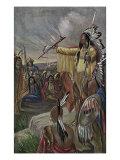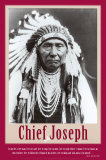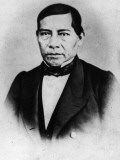|
|
|
|
|
|
|
|
|
|
|
|
BOOKS ABOUT NATIVE AMERICAN CHIEFS
|
|
|
|
|
|
|
|
|
|
|
|
|
|
|
|
|
|
|
|
|
|
 |
|
|
|
|
|
|
|
|
|
Hiawatha (Ayenwatha or Haiëñ'wa'tha; Onondaga)
fl. 1100s, 1400s, or 1500s
Hiawatha, a follower of The Great Peacemaker, is credited as the founder of the Iroquois confederacy, known as the Haudenosaunee, a political and cultural union of the Iroquois, Senecas, Cayugas, Onondagas, Oneidas, and Mohawks, in the present day region of upper New York state. The confederacy modeled a balance of power and decision making by consensus to which each representative had an equal voice. In 1721 the Tuscarora nation joined the Iroquois confederacy, today known as the Six Nations.
Both Thomas Jefferson and Benjamin Franklin had direct contact with the Iroquois confederacy; the influence, if any, of the confederacy on the US Constitution is hotly debated.
• Encyclopedia of the Haudenosaunee (Iroquois Confederacy)
• Howard Zinn on Democratic Education
“No laws and ordinances, sheriffs and constables, judges and juries, or courts or jails – the apparatus of authority in Europena societies – were to be found in the northeast woodlands prior to the European arrival. Yet boundaries of acceptable behavior were firmly set. Through priding themselves on the autonomous individual, the Iroquois maintained a strict sense of right and wrong...” Gary Nash, quoted by Zinn.
• Leon Shenandoah
• Jake Swamp
|
|
|
|
Ishi
ca. 1860; California
d. 3-25-1916; tuberculosis
Ishi is believed to be the last Native American in Northern California to have lived most of his life completely outside the European American culture.
|
|
|
|
Chief Joseph
(c. 1840-1904)
“Let me be a free man, free to travel, free to stop, free to work, free to trade where I choose, free to choose my own teachers, free to follow the religion of my fathers, free to think and talk and act for myself...”
CHIEF JOSEPH, 1879
Poster Text: “Our chiefs are killed. ... The old men are all dead. ... The little children are freezing to death. My people, some of them have run away to the hills and have no blankets, no food. No one knows where they are, perhaps freezing to death, I want to have time to look for my children and see how many of them I can find. Maybe I can find them among the dead. Hear me, my chiefs. My heart is sick and sad. From where the sun now stands I will fight no more forever.”
Chief Joseph was the leader of the Nez Percé Indians. In 1877, the U.S. government tried to drive the Percé from their home in the Wallowa Valley of Oregon to a reservation in Idaho. Instead, Chief Joseph led his tribe on a retreat toward Canada. The tribe was eventually stopped 40 miles from the Canadian border and sent to a reservation in Oklahoma. Chief Joseph's tribe was later relocated to a reservation in Washington state.
|
|
|
|
Benito Pablo Juarez
b. 3-21-1806; Oaxaca, Mexico
d. 7-18-1872; Mexico City
Benito Juarez, a Zapotec Indian from Oaxaca, was the first president of Mexico, serving five terms between 1858-1872.
In 1885 de Juarez was appended to Acapulco in honor of Juarez.
|
|
|
|
|
|
|
|
|
previous page | top | next
List Notable Native Americans > a | b | c | d-e-f-g | H-I-J | k-l | m | n-o-p-q | r | s | t-v-w-x-y-z
|
|
I have searched the web for visual, text, and manipulative curriculum support materials - teaching posters, art prints, maps, charts, calendars, books and educational toys featuring famous people, places and events - to help teachers optimize their valuable time and budget.
Browsing the subject areas at NetPosterWorks.com is a learning experience where educators can plan context rich environments while comparing prices, special discounts, framing options and shipping from educational resources.
Thank you for starting your search for inspirational, motivational, and educational posters and learning materials at NetPosterWorks.com. If you need help please contact us.
|
|
|
|




















